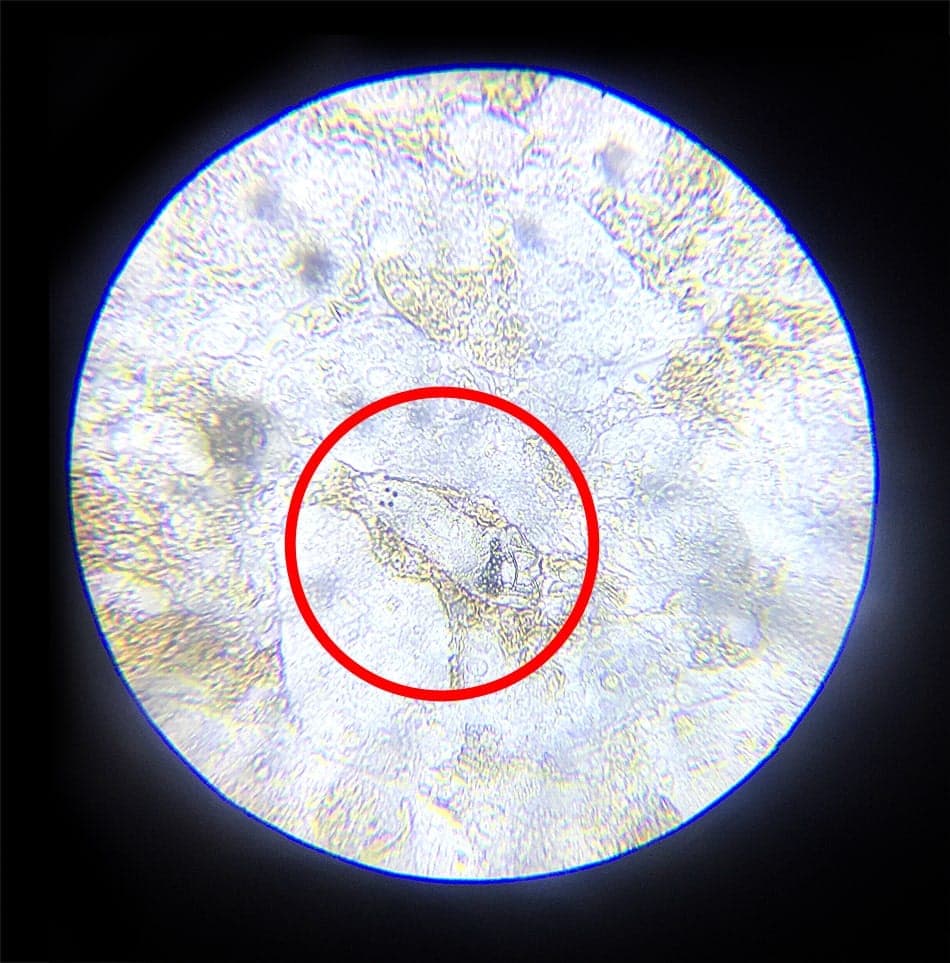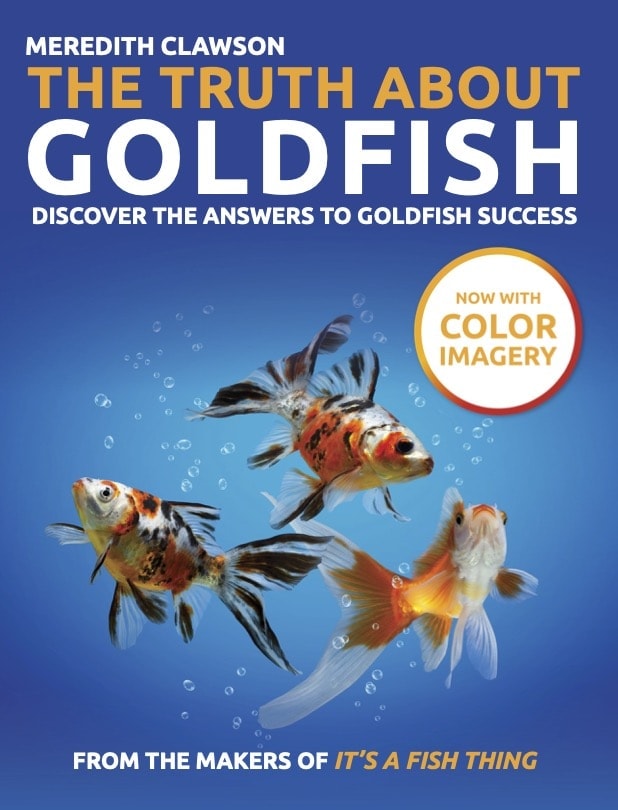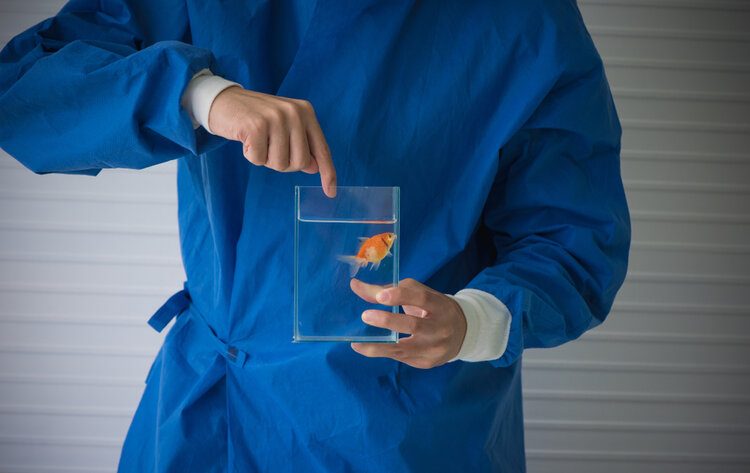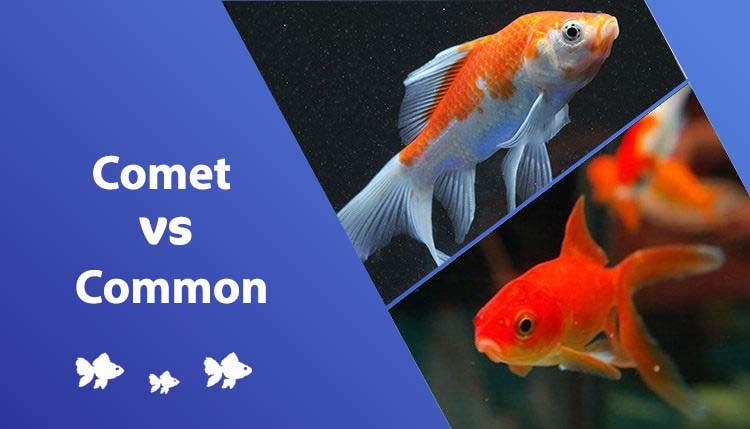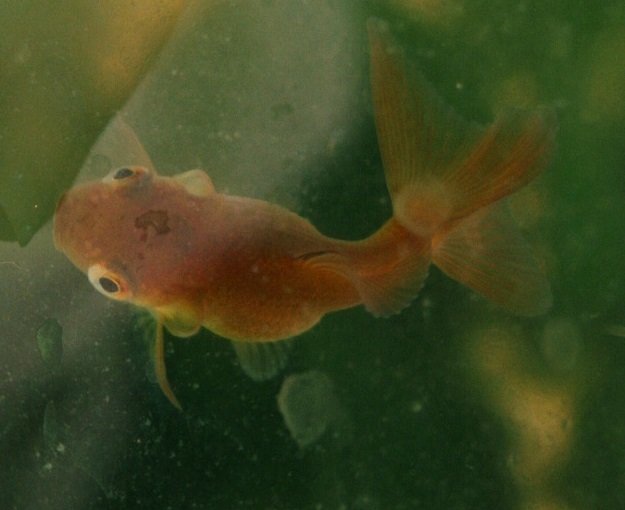How to Treat Goldfish Flukes in 5 Steps (Disease Control)

Updated on
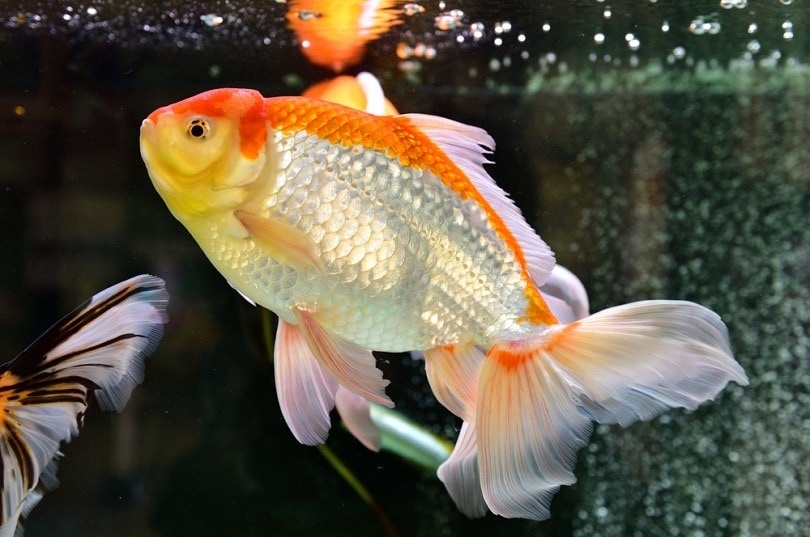
I’ve got some bad news: Your goldfish may have come to you with more than fins, scales and a cute face, and it’s likely to have little invisible pests (and this one is possibly the most common). Unless you get your fish from a trusted breeder or importer who thoroughly quarantines all of their fish before sending them out, there’s a good chance that your fish has ’em.
But how do you tell for sure if your pet even has goldfish flukes? More importantly, how do you get RID of them – and for good? Keep reading to learn more!
What Are Flukes Anyway?
Meet the fluke. This itsy bitsy, creepy, wormy-ish parasite is far more sinister than it sounds. It’s a true freak of nature. There are two kinds: Dactylogyrus (aka gill flukes) and Gyrodactylus (aka body or skin flukes).
Here’s a Dactylogyrus I found on the gills of one of my new goldfish, who presented with a serious fluke infection:
Notice the 4 eye-spots on the left side? Even creepier – the pair of anchor-like hooks to the right? Flukes do TONS of damage to goldfish by chewing away at their slime coat to suck the fish’s blood. *Ew!* This then makes them vulnerable to dangerous secondary infections. Left untreated in an aquarium, a fluke problem can kill your fish.
You don’t have to worry too much about whether your fish has gill flukes or body flukes because, 99% of the time, they are found together (and treatment is the same).
Here is one in action:
How to Identify Flukes in Goldfish?
There are 2 main ways to determine if your fish has flukes. First is:
1. Microscopy
Using a microscope is the only 100% reliable way of diagnosing a variety of goldfish diseases, and flukes is not excluded. Flukes are invisible to the naked eye, but they are quite large under even a low-powered magnification on a microscope slide.
Getting a fluke on one requires taking samples from your goldfish, which is really much simpler than it sounds. A gill scrape or clipping and a mucus scrape from the fish’s body are typically both performed. Taking scrapes from your fish is another topic altogether.
2. Symptom Observation
If you don’t have a microscope, identifying flukes isn’t quite as easy. The symptoms of flukes in goldfish can be exactly the same as those of other parasitic or water quality problems. So, just because your fish does the following doesn’t always mean flukes are the culprit.
But many times, flukes are the cause of the following:
- “Clamped” fins (held close to the body)
- Scratching the body on the walls and objects in the tank, possibly rolling/darting around wildly
- Gasping at the surface for air
- Isolation
- Excess slime production
- Labored breathing
- Ulcers
If your water quality tests are good and you don’t see other external signs of parasites, there’s a good chance you could have a fluke problem on your hands.
If you think your goldfish may have a parasite but you aren’t sure which one, you should check out our best-selling book The Truth About Goldfish, on Amazon.
It provides visuals of each possible ailment so you can diagnose accurately and start treating your pet ASAP so you can save your fish and keep them healthy.
How to Treat Goldfish Flukes?
Because flukes are so common, it’s generally the best option to presume the fish has come with them and treat accordingly (unless it has been pre-treated for them before it came to you).
Treatment for flukes has traditionally been the drug Praziquantel, sometimes shortened to Prazi or by the trade name Prazipro.
I used to use this on my new fish, but I don’t anymore (and never plan to again)!
- Increased parasitic resistance – Flukes are becoming increasingly tolerant of Prazi which has been so widely used by fisheries. Its effectiveness is being questioned by more and more goldfish keepers in recent years as many folks are finding Prazi is not ridding their fish of flukes – even at the recommended duration of treatment.
- Cancer-causing – Praziquantel is potentially carcinogenic. Why would I want to expose myself or my fish to something that can cause tumors if I didn’t have to?
- Potential stress to fish – Prazi itself is relatively gentle, but liquid formulas (which are the easiest to use and most common on the market) often contain other ingredients to help Praziquantel stay in a liquid state, which have been known to cause stressful reactions and irritation to the fish.
- Harmful to the environment – Not the main reason, but I always felt really bad putting this stuff in the water systems after a water change.
Other products marketed for ridding your fish of flukes typically include combinations of formalin (aka formaldehyde) or other aldehydes mixed with malachite green. The problem with these is that they need to be used as a short-term bath treatment at a high dose to be effective, followed by a 100% water change. This is definitely not practical for ponds and is a hassle for aquarium owners, which is why bottles of these solutions are sold at a lower dose and used over the course of a week or so. But here’s the catch: They don’t work well at a low dose. Not to mention how carcinogenic these medications are to you and your fish. So what do I use instead?
My secret go-to fluke treatment is highly effective, all-natural, environmentally friendly, easy to use, safe when used as directed and NOT cancer-causing. It’s a product called MinnFinn.
I found out about MinnFinn several years ago when I had a fluke problem with an imported fish that just wouldn’t go away. And it works. Meaning, it REALLY works. This stuff is literally a life-saver, and I would not consider getting any new pet store or un-quarantined imported fish without it.
It’s also backed by several controlled studies done by the inventor in independent fish importing operations, so you can have peace of mind knowing this stuff is the real deal. And as if an effective fluke treatment option alone was not enough, it also treats almost all the other common goldfish diseases. Talk about cost-effective!
You don’t have to worry about parasites becoming immune to this treatment because it relies on oxidant disinfection technology that will not cause resistance. Nice, right?
It comes in a small size for small aquariums and a large size for large tanks or ponds. The large size is also the most cost-effective option for the amount. Simply follow the directions closely. You will need to use a double dose when treating goldfish or koi if using the little bottle for aquariums. The big bottle for koi and goldfish is already at double strength.
So, why a double dose? These fish have a thicker slime coat (which acts like a protective coat the parasite from treatment) and need a stronger treatment concentration to get to where the parasite is hiding and kill it.
Get this: At regular strength, this product also works at controlling flukes in other freshwater and marine fish as well!
5 Steps to Treat Flukes in Goldfish
- 1. Calculate the amount of medication needed for your tank size. Double the doses if using MinnFinn Mini.
- 2. Add an airstone to ensure proper oxygenation in the water during treatment.
- 3. Dilute the treatment according to the instructions and pour half of the MinnFinn mixture gradually over the bubbles of the airstone.
- 4. Wait for 5 minutes to ensure the fish do not show signs of stress, then add the remaining diluted medication.
- 5. Set a timer for 60 minutes. At the end of the treatment time, neutralize the medication with NeuFinn as per the instructions. Do not skip this step when the time is up.
Repeat this process every 48 hours for a total of 3 treatments in most cases. Severe cases can have up to 5 treatments and is sometimes necessary if you are dealing with dacts, which are notoriously difficult to get rid of.
Note that during treatment, fish should show a mild change in behavior, including lethargy and labored breathing. This means it is working. As long as the fish don’t show signs of distress, this is totally normal. If at any point during treatment the fish look distressed (i.e. appear to be falling asleep or rolling over), simply apply NeuFinn.
The most satisfying part of this treatment for me is always doing a follow-up microscope scrape of the fish and finding a ton of dead flukes. You don’t have to do that if you don’t want to though.
Fluke FAQ
Where do Flukes Come From?
Goldfish can get flukes from the ponds they are often raised in before they are shipped to the pet store or a retailer.
In really large ponds, flukes aren’t a real threat to goldfish because the large volume of water makes it difficult for a newly hatched fluke parasite to find a host. So, a fluke or two here and there isn’t really harmful to the fish. But in a closed aquarium environment where parasites can multiply to dangerously high numbers, they have to be dealt with or they will eventually kill the fish.
Why are they So Bad?
Flukes cause considerable stress to the goldfish, to the point where it will kill them. This disease is nothing to mess around with. It can cause secondary bacterial infections that prove fatal for the goldfish.
Many times, goldfish that have ulcers are actually being attacked by flukes, which leave them vulnerable to the bacteria that cause ulcer disease or even dropsy. Ulcer disease can wipe out an entire collection in a matter of days. Fast treatment to prevent things from getting this far is very, very important.
Are they Contagious from Fish to Fish?
Yes, they are. Highly. It can spread through entire tanks and wipe out fish that were previously healthy. That is why it is so important to always quarantine new fish.
The good news? People can’t get them.
What if I can’t get MinnFinn in my Country?
Depending on where you live, if you can’t get MinnFinn and you don’t want to use Prazi, you’ll have to consider other options. Admittedly, there aren’t many effective ones.
Now, I have talked to some folks in other countries who use products containing the active ingredient Flubendazole, which is a deworming medication and have found it to work very well. Some anecdotal accounts say it also treats ich.
Fish Bendazole is one commercial version with dosage rates for fishkeepers. It’s often used to get rid of planarian worms (harmless cousins of flukes). As I haven’t used it, I can’t speak directly to its effectiveness, but might be worth a try.
Conclusion
Flukes are a nasty goldfish disease, but it’s one that has a good treatment available. Caught early enough, most goldfish will get through a case of this with flying colors.
What are your thoughts? Have you ever had to deal with a case of flukes in your goldfish?
Featured Image Credit: Japan’s Fireworks, Shutterstock

